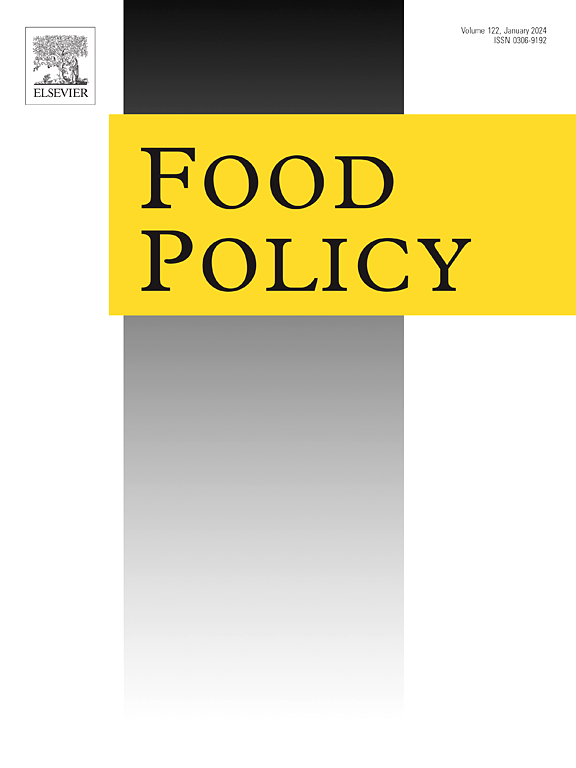How do women’s empowerment metrics measure up? A comparative analysis
IF 6.8
1区 经济学
Q1 AGRICULTURAL ECONOMICS & POLICY
引用次数: 0
Abstract
Research has identified women’s empowerment as a critical factor for nutritional outcomes and a priority area for understanding women’s mental health status. At the same time, there is no consensus on how empowerment should be measured. The surrounding debate has produced several empowerment metrics that are widely used, yet we know little about whether they can be substituted for one another or their respective strengths and weaknesses. Using data collected from a single sample of women from rural, northern Kenya, we compare five empowerment metrics: The Project-level Women’s Empowerment in Agriculture Index (pro-WEAI) and associated Health and Nutrition Module (HN), Women’s Empowerment in Nutrition Index (WENI), Women’s Empowerment in Livestock Index (WELI), and the Survey Based Women’s Empowerment Index (SWPER). The metrics have shared theoretical origins and are commonly used in the food, nutrition and health spaces to study rural women’s lives across low- and middle-income countries. We examine the metrics’ characteristics, distributions, pairwise correlations and capacity of each metric to predict outcomes often associated with the concept of empowerment: body mass index (BMI) and the Center for Epidemiologic Studies Depression Scale (CES-D). We find striking differences between these common empowerment metrics. The metrics’ correlations with one another are highly variable as are the predictive capacities for both outcomes. Further, our analysis finds that the choice of metric can dramatically influence which individuals are identified as empowered. In sum, our results suggest that while these metrics are used in remarkably similar ways to understand rural women’s empowerment and its consequences, unless they are computed with many identical survey questions, the metrics do not capture the same underlying concept and are not interchangeable. We recommend that our work be replicated elsewhere and caution should be taken when implementing and interpreting research using these metrics, as findings may be highly sensitive to the choice of metric.
如何衡量妇女赋权指标?比较分析
研究发现,妇女赋权是营养结果的关键因素,也是了解妇女心理健康状况的优先领域。与此同时,对于如何衡量妇女赋权还没有达成共识。围绕这一问题的讨论产生了几种被广泛使用的赋权指标,但我们对这些指标是否可以相互替代或它们各自的优缺点知之甚少。利用从肯尼亚北部农村妇女中收集到的单一样本数据,我们对五种赋权指标进行了比较:项目层面的农业妇女赋权指数(pro-WEAI)和相关的健康与营养模块(HN)、营养妇女赋权指数(WENI)、牲畜妇女赋权指数(WELI)以及基于调查的妇女赋权指数(SWPER)。这些指标具有共同的理论渊源,通常用于食品、营养和健康领域,以研究中低收入国家农村妇女的生活。我们研究了这些指标的特征、分布、配对相关性以及每个指标预测与赋权概念相关的结果的能力:体重指数(BMI)和流行病学研究中心抑郁量表(CES-D)。我们发现这些常见的赋权指标之间存在显著差异。这些指标之间的相关性差异很大,对两种结果的预测能力也是如此。此外,我们的分析还发现,指标的选择会极大地影响哪些人被认定为有能力的人。总之,我们的研究结果表明,虽然这些指标在理解农村妇女赋权及其后果时的使用方式非常相似,但除非它们是通过许多相同的调查问题计算出来的,否则这些指标并不能捕捉到相同的基本概念,也不能互换。我们建议在其他地方复制我们的工作,在使用这些指标实施和解释研究时应谨慎,因为研究结果可能对指标的选择非常敏感。
本文章由计算机程序翻译,如有差异,请以英文原文为准。
求助全文
约1分钟内获得全文
求助全文
来源期刊

Food Policy
管理科学-农业经济与政策
CiteScore
11.40
自引率
4.60%
发文量
128
审稿时长
62 days
期刊介绍:
Food Policy is a multidisciplinary journal publishing original research and novel evidence on issues in the formulation, implementation, and evaluation of policies for the food sector in developing, transition, and advanced economies.
Our main focus is on the economic and social aspect of food policy, and we prioritize empirical studies informing international food policy debates. Provided that articles make a clear and explicit contribution to food policy debates of international interest, we consider papers from any of the social sciences. Papers from other disciplines (e.g., law) will be considered only if they provide a key policy contribution, and are written in a style which is accessible to a social science readership.
 求助内容:
求助内容: 应助结果提醒方式:
应助结果提醒方式:


